Abstract
Due to the insufficient consideration of medium and long-term wind power contract power in short-term dispatch, long-term planning and real-time consumption of wind power cannot be effectively undertaken, resulting in a large amount of abandoned wind power. A way to improve the wind power absorption capacity has become an urgent problem to be studied. According to the characteristics of the market and dispatching in the process of wind-fire integration construction, this paper constructs a wind power consumption model that connects the mid- and long-term transaction power decomposition and short-term dispatch. Considering the unit output characteristics and maintenance, the monthly contract electricity is decomposed into daily electricity, and the nesting of medium and long-term transactions and short-term scheduling is realized; the second stage is a short-term multi-objective optimal scheduling model considering the decomposition of contract electricity and the output of non-bidding units to improve the real-time consumption of wind power. Finally, a province in northwest China is taken as an example to verify the effectiveness of the proposed method.
1. Introduction
At present, China is in the process of optimizing its energy and power structure. Based on the new concept of green development, China has become more and more concerned about environmental protection. In August 2022, energy-related departments have issued various policies to reduce carbon emissions [1]. The “Energy Production and Consumption Revolution Strategy” proposes that by 2030, non-fossil energy will account for 20% of the total energy consumption when the carbon emission level will reach the world average level, and the carbon emission per unit of GDP will be reduced to 60% compared to 65% in 2005. The participation of new energy in the market can improve the economy of system operation, and can also promote wind power consumption and reduce wind curtailment [2]. The results of Zhang C et al. [3] also show that with the participation of wind turbines, the system performance has been improved to a certain extent, and the proposed DEMPC strategy has high efficiency. Replacing fossil energy with renewable energy as the leading energy source is indeed an effective measure to solve the problems of sustainable energy supply and climate change. At present, the installed capacity of a series of clean energy sources such as wind power has maintained rapid development. However, due to the randomness and volatility of wind power output, the phenomenon of wind curtailment is relatively serious, which has brought huge resistance to the operation and development of China’s power grid.
Based on the above background, in order to promote wind power consumption, researchers have carried out a lot of research work and obtained a series of research results: Algieri A et al. [4] are studying the basis of combined heat and power (CHP), adding wind power and photovoltaic systems, which can not only meet the power demand and heat demand of users, but also improve the adaptability of wind power and reduce pollutant emissions. Based on the flexibility of the heat grid, Mu Y et al. [5] propose a scenario-based optimal dispatch for the combined operation of wind farms and combined heat and power (CHP) plants. The results show that the benefits of joint operation are not only improved, but the cogeneration power plant in the joint system can compensate the fluctuation of wind power output, promote the grid-connected consumption of wind power, and reduce the penalty cost caused by the uncertainty of wind power. The utilization of new energy is often combined with energy storage. For example, Zhang et al. [6] established a two-layer optimization model according to the uncertainty of wind power output, and determined the energy storage configuration capacity including wind power participation, so as to maximize wind power consumption and minimize system operating costs. Hauer I et al. [7] used the battery energy storage system (BESS) to improve the integration and optimal utilization of wind energy, and reduce the unbalanced cost by about 37.5% while storing the wind power abandoned by the wind; Li J et al. [8] found that in view of the problem of insufficient peak regulation of the power system caused by severe wind curtailment in the power grid during the heating period in the “Three North” regions of China, the flexibility of the power system can be enhanced by configuring flexible loads to improve the acceptance of wind power, which is important for wind power and high wind power. The safe and stable operation of infiltration into the power grid is of great significance; Chen Z and Simla T et al. [9,10] all combined the energy storage system with wind power to reduce the uncertainty and volatility of wind power generation and achieve the optimal consumption of wind power. These studies have made great contributions to the energy storage equipment in China while reducing the amount of wind power abandoned. In addition, wind power can also be dispatched jointly with other traditional energy sources. Rong S et al. [11] established a coordinated dispatch method for a hybrid system of multiple power sources, with the maximum additional wind consumption and the highest economic benefit as the optimization goal, to realize additional wind power. In consideration of consumption and maximization of economic benefits, Yang Y et al. [12] established a two-layer nested model of the water and wind complementary system according to the fluctuation characteristics of wind power in adjacent time intervals, so as to provide instructions for daily power generation scheduling, reduce the impact of unit uncertainty and improve adaptability to the uncertainty of wind power. Jiang T et al. [13] showed that the joint dispatch mode realizes the synergistic effect of different energy resources of co-thermal power plants, promotes wind power adaptation, and reduces fossil fuel consumption. Xu J et al. [14] propose an isolated power grid driven by thermal power and wind power, and build high-power-consuming enterprises in energy-intensive load industrial areas to consume wind power on-site, effectively alleviate the problem of wind abandonment, and correspondingly reduce the high power consumption cost of industrial load production. Tan et al. [15] took a region in Xinjiang, China as an example, and constructed a wind-fire joint dispatch optimization model under the carbon emission trading mechanism to reasonably arrange thermal power generation and renewable energy power generation. The entire model not only considers the spillover rate of renewable energy; the impact of the dispatching system and a model for predicting the output of renewable energy generation has also been developed. In this way, the model alleviates the serious problem of power curtailment in the existing dispatching mode and helps to achieve economical and low-carbon dispatching of the power system. In order to determine the coordinated operation mechanism of the large-scale charging power system for electric vehicles, and considering the characteristics of wind power that cannot be fully connected to the grid due to insufficient peak shaving capacity, Zhang et al. [16] established a new type of power system such as economy, pollutant emission, and abandoned air volume. Considering a system dynamic multi-objective scheduling model to optimize the output of wind power and thermal power, Tan Q et al. [17] proposed a cost accounting model that considers price fluctuations based on China’s carbon emissions trading and renewable energy portfolio standards to explore carbon emissions trading and renewable energy. The impact of combination standards on wind-solar-thermal power integrated dispatching systems. These results can help dispatch departments evaluate the impact of carbon emissions trading and renewable energy combination standards to optimize dispatch strategies and provide guidance for decision makers to improve designs. Lu M et al. [18] established a day-ahead optimal dispatch model for the power system combining wind power-hydropower-heat pumped storage, which can improve the economic benefits of the power system, reduce the number of start-up and stop of thermal power, and reduce the fluctuation coefficient. Dong et al. [19] established a multi-objective and multi-constraint optimal scheduling model for the wind-water-thermal power generation system based on the characteristics of the integrated energy coordination control of wind, water and fire, which not only effectively solved the nonlinear, multi-dimensional and discontinuous characteristics of the combined system with many constraints and other issues, but also attached great importance to the use of clean energy to reduce the operating cost and power output variability of thermal power units. Jang et al. [20] proposed a hybrid optimization method based on particle swarm optimization and gravitational search algorithm, namely gravitational particle swarm optimization algorithm, to solve the problem of wind power generation system considering wind power. In relation to the economic and emission joint scheduling problem of availability, Dasgupta K et al. [21] developed a new algorithm for the dynamic economic emission scheduling problem, which effectively combines wind power generation with traditional thermal power generation and finally achieves the minimum power generation cost and pollutant emissions. Yang et al. [22] considered that when the penetration rate of renewable energy is high, it is difficult to balance the relationship between system economy and peak shaving performance only by relying on the transformation and optimization of thermal power units. Based on the coordinated planning method for unit flexibility retrofit, a source-storage planning scheme that takes into account system economy and wind power receiving capacity is obtained. In these studies, it is shown that a combination of renewable energy and thermal power is most suitable for China, as China’s current energy mix dominated by thermal power is expected to last for decades, while nuclear power and hydropower are more commonly used for baseload and are not conducive to peak regulation. Therefore, when large-scale renewable energy is connected to the grid, the deployment of integrated wind power and thermal power dispatching in China is more realistic.
In addition, the above literature, whether it is cogeneration, energy storage configuration or joint dispatch of traditional energy and wind power, is aimed at the research of centralized dispatch mode under the environment of full guaranteed wind power acquisition. Xu X and R Zhang et al. [23,24] is also based on this operation mode, and analyzes the parity policy of China’s wind power grid, as well as the effectiveness and decisive factors of the grid price policy at the national level and the regional grid level. With the continuous improvement of wind power forecasting technology and the continuous reduction of wind power cost, wind power participation in the market is an inevitable trend. At present, only a few studies have considered the dispatch mode of wind power participating in market transactions, such as wind power participating in real-time market: Dong et al. [25] design proposed a new reserve capacity mechanism and analyzed the effect of reserve compensation mechanism and system parameters on wind power consumption results to ensure the stable consumption of wind power in the real-time market stage. At present, China is in the transitional period of the power market, and the market transactions are mainly in the medium and long term. With the transformation of China’s power market from a vertical monopoly model to a market-oriented model that gradually opens up the power generation side, the grid side, and the user side, renewable energy such as wind power has entered the market. Subjects can also participate in market competition. On this premise, Zhang J et al. [26] proposed a stochastic optimal dispatch model that considers medium and long-term power transactions in wind power integrated energy systems, and introduced the power contract decomposition problem into the early optimal dispatch plan. To better plan wind power consumption on a long-term scale, Jiang Y et al. [27] proposed a two-tier decision-making model based on the monthly power purchase. The model integrates demand-side response, energy storage, wind power consumption and advance power purchase planning. The monthly purchase volume and its hourly decomposition plan are optimized to promote monthly market benefits. Fan et al. [28] proposed a two-level optimization model for wind power plants and thermal power units to participate in mid- and long-term power market and day-ahead market transactions. First, the mid- and long-term contract electricity was decomposed into the day-ahead market, and then the wind farm and day-ahead market were proposed. After analyzing the two ways for thermal power units to participate in the power market, the results show that the joint participation of wind farms and thermal power units in the power market has additional benefits compared to independent participation.
With the maturity of China’s power market, it has gradually become fully marketized. Based on this, many studies have considered the impact of wind power participation in the market, but have ignored the effective connection between mid- and long-term market wind power transactions and short-term wind power dispatch. If the connection between the market and dispatching is not considered, the short-term dispatching peak regulation may be insufficient in actual operation [29], and the purpose of wind power consumption cannot be achieved. The consumption of wind power and short-term dispatch play a positive role in the real-time consumption of wind power. The nesting of the two plays an important role in the safe and economical operation of the power system with a high proportion of wind power access, the stable and efficient operation of the market, and the promotion of renewable energy consumption.
Based on the above literature research, this paper proposes a wind power consumption model for the connection between bidding and dispatching. First, after the wind and thermal power participates in the monthly bidding transaction, the monthly wind and thermal power wins the bid, and then the monthly wind and thermal power obtained from the bidding is decomposed. Then, according to the research results of the literature [30], a short-term dispatch model is established to minimize the economic and environmental costs, which can reduce the curtailment of wind power and coal consumption while improving the economy of system operation.
2. The First Stage: Medium and Long-Term Wind and Thermal Power Transactions and Electricity Decomposition
At present, transactions in China’s electricity market can be mainly divided into medium and long-term transactions and spot market transactions. The main types of mid- to long-term transactions are annual bilateral negotiated transactions, monthly centralized bidding transactions, and listing and delisting transactions. The monthly wind-thermal power bidding transaction model in this paper refers to [29], which plans the consumption of wind power on a long-term scale and locks the consumption of wind power in advance. Since bidding transactions are already common, this paper focuses on subsequent power decomposition and short-term scheduling issues.
2.1. Medium and Long-Term Auction Transactions
The main ways for wind power to participate in the medium and long-term transactions in the power market are as follows: (1) wind farms do not offer quotations, and accept market clearing prices as price receivers; (2) wind farms should treat wind turbines as conventional units and participate in market decision-making and quotations. As the cost of wind power generation decreases, wind turbines participate in market quotations and settle according to the wholesale electricity market price. Among them, wind and fire bundling to participate in medium and long-term transactions in the electricity market is an important means of wind power consumption. Participating in the bidding of wind power is mainly in the mode of centralized bidding.
The centralized bidding transaction mode requires that within a specified time, both parties of the transaction apply for the amount of electricity traded and the compensation quotation on the power transaction operation system. The power trading operation system conducts centralized matching of all units participating in the quotation through a unified trading platform in accordance with the principles of energy conservation priority, price priority, and time priority. The two parties to the transaction sign a power generation right transaction contract according to the transaction results confirmed by the power transaction operation system, specifying the transaction period, transaction volume, transaction price, settlement method, etc. At this stage, the core idea of centrally matching and organizing transactions is “high-low matching”, that is, buyers and sellers are prioritized in descending order of quotations. In this paper, monthly bidding transactions are carried out. The quotations of m power generation companies are arranged from low to high, and the quotations of n electricity sales companies (large users) are arranged from high to low. The price corresponding to the intersection of the declared electricity quantity is used as the transaction price. The monthly bidding price is shown in Figure 1.
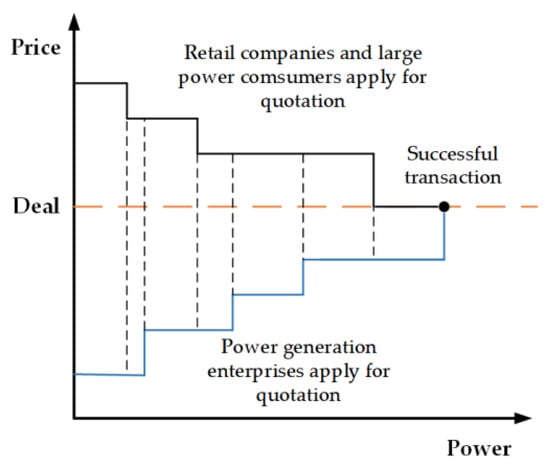
Figure 1.
Schematic diagram of monthly centralized bidding quotation.
At the market level, considering that the minimum electricity purchase cost is taken as the objective function in the electricity market where only the power generation side is open to bidding transactions, and the electricity market where both the generation side and the electricity consumption side are open to bidding transactions, the objective function of the market transaction is social welfare. This paper studies a two-sided market in which both the sender and the user participate in the bidding, so the bidding target is the maximum social welfare, and the flow chart of the operation strategy is shown in Figure 2.
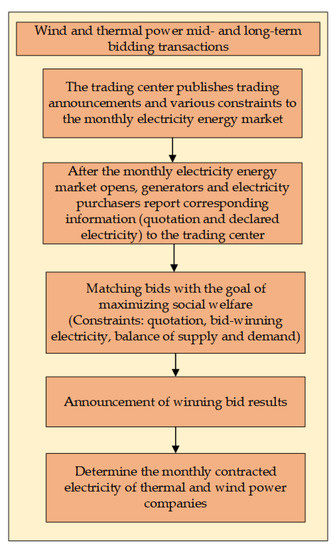
Figure 2.
Mid- and long-term transaction flow chart.
First, the trading center issues a transaction announcement to the society. After the market opens, the developers and the electricity purchasers make reasonable quotations in turn according to market rules, as well as the power generation and electricity consumption. With the goal of maximizing social welfare and the interests of both parties, the respective winning bid prices and winning bids for electricity generators and electricity purchasers are then determined, and the monthly bidding ends.
2.2. Decomposition of Medium and Long-Term Transaction Electricity
The decomposition of contract electricity is a problem that trading centers generally need to solve. Generally speaking, the annual or monthly contract electricity is usually distributed in proportion to the load and the capacity of the unit, but the abandonment of wind turbines and the maintenance characteristics of other units are not considered, which will lead to difficulty in scheduling implementation. Therefore, the decomposition of the first stage must not only ensure the minimum amount of wind turbines abandoned, but also ensure that the thermal power units are as fair and feasible as possible in each period, and also consider the cost of maintenance. Based on the above analysis, this paper proposes a monthly contract electricity decomposition method considering the characteristics of wind power output and unit maintenance, which makes the output of the two types of units have strong correlation and complementarity while improving wind power consumption. The general idea of decomposition is shown in Figure 3.
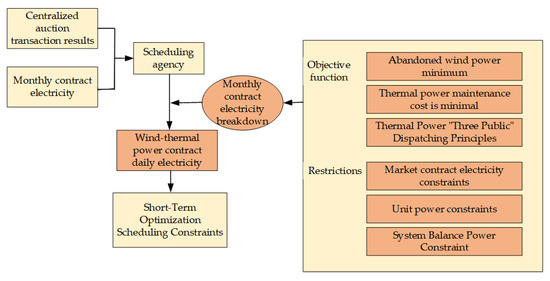
Figure 3.
Decomposition of monthly contract electricity.
The decomposition of monthly electricity needs to consider two aspects in the process: (1) Whether the decomposition of each unit in the specified number of days is in line with the operation of the unit; (2) whether the electricity of all the components of each day meets the daily contract requirements. It is also necessary to consider the constraints of “unit” and “time period” in the decomposition process, as well as the capacity reserve requirements of each unit’s internal operation. Based on the above considerations, the model is as follows:
2.2.1. Objective Function
In this paper, while studying the problem of long-term power decomposition in the integrated power system of wind power and thermal power, the optimization of the maintenance plan of the unit is considered. The purpose of this paper is to ensure the completion of the contracted power of each unit, arrange the maintenance period of the unit reasonably, reduce the maintenance cost of the unit, ensure the economy, and improve the utilization rate of new energy and reduce the amount of abandoned air during resource-rich periods. The specific objective function is as follows:
- (1)
- Abandoned wind power is the smallest
Due to the uneven distribution of wind resources on the time scale, the amount of wind power generated in different periods varies. The model selects the amount of wind and solar power abandoned as the corresponding objective function in the time period with abundant resource distribution, aiming to make full use of the complementarity between multiple energy sources, and improve the consumption of new energy while completing the power decomposition of the unit. The objective function is the abandoned wind power in the process of power decomposition:
where represents the decomposed electricity of the wind turbine on the t day; is the cost of wind abandonment; is the maximum power generation capacity of each wind turbine; is the total number of days of decomposition, with 30 days as a month; is the number of bidding wind farms; indicates the maintenance status of the wind turbine, 0 and 1 indicate that the wind turbine is in maintenance and normal operation, respectively.
- (2)
- The maintenance cost of the unit is the smallest
It is important to consider the optimization of unit maintenance on the premise of ensuring that the unit can complete the contracted electricity, reasonably arrange the unit maintenance period to reduce the unit maintenance cost to ensure economic efficiency, and to improve the utilization rate of new energy and reduce wind curtailment.
where is the number of thermal power bidding units; is the maintenance status of the thermal power unit, 0 and 1 indicate that the unit is in the maintenance and normal state respectively; is the maximum power generation capacity of each thermal power unit; is the unit maintenance coefficient.
- (3)
- Progress of thermal power units
The objective function reflects the requirements of the “Three Public” dispatching principle. high or low completion rate violates the principle of fair dispatch. Therefore, the objective function considers the progress of the power generation plan of the thermal power plant, so as to ensure the completion of the power generation of each thermal power plant in the process of power decomposition. Consistency of progress:
where represents the decomposition power of thermal power plant on the day; is the progress coefficient of the thermal power plant, and its meaning is the ratio of the utilization rate of the maximum power generation capacity of the thermal power plant to the utilization rate of the maximum power generation capacity of the power plant in the entire effective period in the first time units; is the average value of the progress coefficients of all thermal power plants in the time period ; is the monthly contract power of thermal power plant ; is the maximum on-grid power of thermal power plant in the period .
In order to solve the above multi-objective model, the original objective function is first normalized by Formula (6), so that the values of the objective function are all within the interval , and the influence of dimension and magnitude on the calculation results is eliminated [31].
where is the normalized objective function; is the three objective functions of Equations (1)–(3); is the optimal solution that makes the objective function become the minimum value and the maximum value obtained when performing single-objective optimization with as the target, respectively.
The three normalized objectives are then weighted and summed, and finally solved using the CPLEX solver.
where is the total operating cost of the monthly power decomposition, is the weight coefficient corresponding to the three objective functions, respectively, satisfying . The three coefficients are determined by expert scoring. The specific method is to invite ten experts to score the three sub-goals, and finally take the average according to the scoring results, take .
2.2.2. Constraints
- (1)
- Contract power balance constraints
- (2)
- Decomposable power constraints
- (3)
- Operational safety constraints
The decomposed electricity in each period should meet the minimum load demand:
where is the minimum load power in period.
- (4)
- The power generation constraints of each unit
- (5)
- Maintenance time constraints and continuous maintenance constraints
3. The Second Stage: Wind-Thermal Power Combined Short-Term Multi-Objective Optimal Scheduling Model Considering Contract Electricity Decomposition
3.1. Objective Function
This paper comprehensively considers the economics of power purchase by grid companies, the coal consumption (i.e., environmental protection) of thermal power units and the ability to absorb wind power. From the perspectives of economic cost, environmental cost of coal consumption, and wind power consumption capacity, a second-stage model is established. The objective function is to establish a short-term multi-objective optimal dispatch model considering the decomposition of contract electricity in the second stage with the goal of ensuring minimum wind curtailment, minimum coal consumption and minimum economic cost of electricity purchase.
- (1)
- The power grid company is the least economical to purchase electricity
For wind-thermal power bidding units, their electricity is divided into two parts: after participating in the monthly bidding transaction, the electricity that has not won the bid can continue to participate in the day-ahead dispatch, and this part of electricity is purchased by the grid company according to the unified electricity price. The monthly market is determined and will not be discussed here. In the existing electricity market environment, the power grid company is responsible for the purchase and sale of non-bidding units, so the total power purchase cost of the grid company is the sum of the power purchase cost of the output of the non-bidding units and the output of the non-bidding units, the objective function:
where is the total power purchase cost of the power grid; is the power purchase cost of the dispatched output of the bidding wind farm that does not win the bid; is the power purchase cost of the wind power non-bidding unit; is the thermal power bidding unit. Electricity cost is the power purchase cost of thermal power non-bidding units; is the number of bidding units in wind farms; is the non-bidding wind farm; is the number of bidding units in the thermal power unit, and is the number of non-bidding units in the thermal power unit.
is the on-grid electricity price of wind power non-bidding units, and this price is also used for the purchase of unsuccessful bids for wind farms in this article; is the on-grid electricity price of thermal power non-bidding units, and this price is also used for the purchase of unsuccessful bids for thermal power units in this article; is the dispatched output of bidding wind farm in time period ; is the output of bidding wind farm in time period to fulfill the contract; is the dispatched output of non-bidding wind farm in time period ; is thermal power bidding unit in time period dispatching output during the period; is the output of thermal power bidding unit in period ; is the dispatching output of thermal power non-bidding unit in period ; is the total number of dispatching periods in the whole dispatching cycle. In this paper the short-term dispatching .
- (2)
- The environmental cost of system operation is minimal
The environmental cost refers to the coal consumption cost of the thermal power generating unit and the wind curtailment cost when the wind farm is operating. Therefore, the environmental cost of the system can be expressed as
where is the wind power cost coefficient; is the predicted output of the i-th wind farm at time ; is the output of the i-th wind farm at time ; is the output of the j-th thermal power unit at time , when is the dispatching output of thermal power bidding units, when is the dispatching output of thermal power non-bidding units.
In this paper, a short-term multi-objective optimal scheduling model is established with the goal of minimizing the economic cost of electricity purchase and the minimum system operating environment cost . According to the optimization results of the three objectives in the literature [29], the third optimization method is adopted as the optimization objective form of this paper: adding the weights of the two objectives to obtain the comprehensive cost of the system, which can minimize the economic cost of the system operation, can also minimize the environmental cost, can be written as
The linear weighting method is used to find the optimal two sub-goals at the same time. In the formula, is the weight coefficient corresponding to the two goals, such as the power purchase economy of the power grid company and the system operating environment cost, and is set for the convenience of calculation and understanding.
3.2. Constraints
In the mode of combining market transactions and short-term dispatch, not only the original constraints of the power system operation, but also the new characteristics brought by market factors such as contract electricity must be considered. Therefore, the specific constraints of the second stage model are as follows:
- (1)
- Power balance constraints
The sum of the outputs of bidding units and non-bidding units at any time period is equal to the load demand of time period , that is,
where is the load demand of the system in period .
- (2)
- System spare constraints
Due to the volatility and randomness of wind power output, it is necessary to provide a certain reserve value to ensure the safety of the system. The specific expression is as follows:
where is the standby coefficient of the system for wind power and load, respectively, and is taken in this paper.
- (3)
- Output constraints of thermal power units
Not only thermal power units must meet their own output constraints, but also the bidding units must meet the contract output constraints. The specific expression is as follows:
where is the running state of thermal power unit (including bidding units and non-bidding units) in period , 0 means it is in a shutdown state, 1 means it is in a startup state; and are the upper and lower output limits of thermal power unit j, respectively. Equation (28) represents the constraints that all thermal power units need to meet, and Equation (29) represents the contract performance constraints that thermal power bidding units must meet in addition to the basic constraints.
- (4)
- Climbing constraints for thermal power units
- (5)
- The minimum start and stop time constraints of thermal power units
In order not to damage the service life of the thermal power unit, the unit should not be switched on and off frequently. Often, it will continue to run or shut down after it has been running for a period of time. Referring to the existing research, the start-stop constraints in this paper are as follows:
where and are the continuous operation and outage time of thermal power unit in period , respectively; and are the minimum time that thermal power unit must maintain the running state and the outage state, respectively; is the impulse function: ; is the parameter related to time , when its parameter is , , when its parameter is , ; is the parameter related to time , when its parameter is , , when its parameter is , .
- (6)
- Output constraints of wind turbines
Similar to the constraints of thermal power units, the dispatched output of wind turbines (including bidding units and non-bidding units) at any time period cannot exceed its predicted output. At the same time, there are constraints on contract performance for bidding units. The specific expression of wind turbine operating constraints is as follows:
where Equation (35) represents the output constraint of wind power non-bidding units, and Equation (36) represents the output constraint of bidding wind farms.
- (7)
- Abandoned wind power constraints
At time t, the abandoned wind power () accepted by the power grid company should not be greater than the total abandoned wind power (), that is, there is
- (8)
- Electricity constraints are enforced on the contract day
As long as the total contract execution power of the bidding wind farm meets the execution power constraints on the contract day, there is no specific requirement on how much output to be completed in each period, so that the wind power can flexibly arrange the output of each period according to the output of the day to ensure the contract. Regarding the executability of daily execution power, the daily contracted electricity of thermal power bidding units needs to meet the daily decomposition value of its contracted electricity. The specific expression is as follows:
where is a definite value of the contract-day execution power generated by the decomposition of the bidding wind farm ; is the tolerance of the contract-day completion power deviation of the bidding wind farm, which is taken as in this paper; is the contract day execution electricity quantity obtained by decomposition of thermal power bidding unit , which is a certain value.
4. Solving Process
Through the modeling of the electricity decomposition model of wind and fire bidding transaction and the short-term multi-objective optimal scheduling model considering the decomposition of contract electricity, both models can be solved by CPLEX. Since the focus of this paper is not on the decomposition of contract electricity, the daily decomposition value can be obtained. Finally, the short-term multi-objective optimal scheduling model is solved. The specific solution and calculation process of the model in this paper is shown in Figure 4.
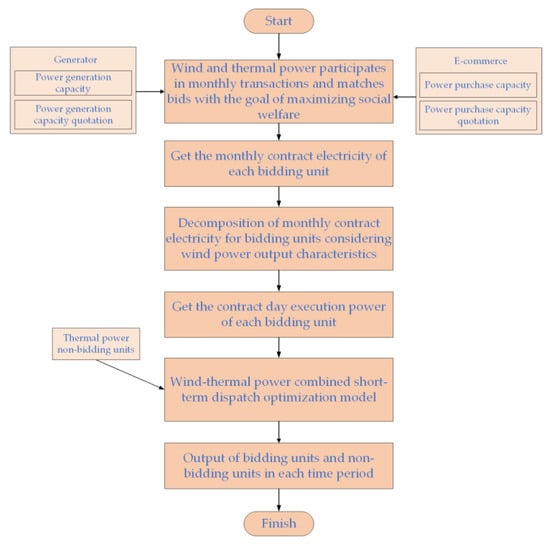
Figure 4.
Technical route.
According to the technical route in Figure 4, firstly, the wind farm and our thermal power plant conduct bidding transactions to obtain the monthly transaction power of wind-thermal power units; then, the monthly wind-thermal power bidding transaction is decomposed to obtain the daily contract power of each bidding unit, and the contract date of each bidding unit. The execution power is incorporated into the dispatching model as a new constraint, and a short-term multi-objective optimal dispatching model considering the decomposition of contract power in the second stage is established.
5. Case Analysis
5.1. Case Description
In the context of wind power integration construction, this paper conducts simulations based on the power market environment of a province in northwest China, combined with the actual data of local wind and thermal power. The province is rich in coal and wind energy resources and is a large-scale power generation base in the northwest region. Its power structure is dominated by coal-fired thermal power and wind power, and the bundled transmission of thermal power and renewable energy is advocated. In order to explore the impact of wind power participation in medium and long-term transactions and the constructed model on wind power consumption, this paper mainly considers the following two situations:
- Case 1: All wind farms participate in mid- and long-term bidding transactions.
- Case 2: Some wind farms participate in mid- and long-term bidding transactions.
5.2. Parameter Setting
In order to facilitate subsequent research, it is assumed that each thermal power unit represents a thermal power plant. The number of thermal power and wind power installed in the modified system is close to 8:3. The thermal power bidding units are G1~G5, the non-bidding units are G6~G8, and the wind farm W1~W3. The units in the system can be divided into two categories: bidding units and non-bidding units as a whole according to whether they participate in market transactions or not. There are both bidding units and non-bidding units in thermal power units. Wind farms can be divided into two situations according to their participation in the market: Case 1 is all bidding wind farms W1~W3; Case 2 has only one bidding wind farm W1, and two non-bidding wind farms W2 and W3. The parameters of thermal power units and wind farms are shown in Table 1 and Table 2. is the wind power cost coefficient, which is taken as 500 yuan/(MW·h) in this article. According to the new notice issued by the National Development and Reform Commission in 2021, the central government will no longer subsidize wind power projects and implement grid parity. With reference to the electricity price approved by thermal power units last year, and are taken as 334 yuan/(MW·h) at the same time. According to the suggestions given in [32], the joint dispatch decision of coal-fired units and wind power will be studied in the future to jointly optimize the power generation mode in terms of economy and environment. In the short-term multi-objective optimization model, the weight setting of the environmental cost of the system operation is relatively large, and the power purchase economy is relatively small, the economic cost coefficient of power purchase is 0.45, and the environmental cost coefficient is 0.55.

Table 1.
Basic parameters of thermal power units.

Table 2.
Basic parameters of wind farms.
Table 1 displays the basic parameters of the 8 thermal power units, including the maximum and minimum output when the unit is running, where , and are the thermal power unit cost characteristic coefficients. The daily load is proportionally reduced by the actual load curve shape of a certain provincial power grid on a certain day so that it conforms to the modified test system load value. The day-ahead load forecast and wind power forecast values are shown in Figure 5.
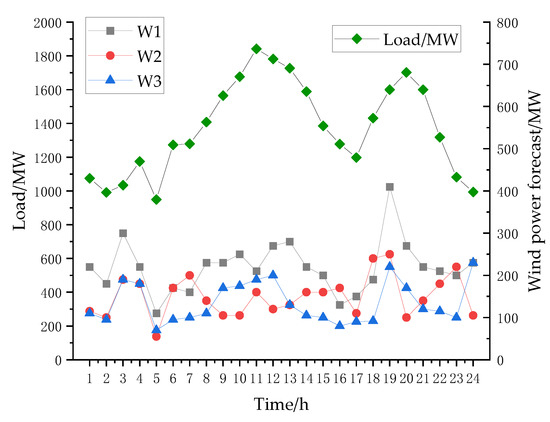
Figure 5.
Daily load curve of a northwestern province and daily forecast curves of three wind farms.
5.3. Analysis of Results
5.3.1. Mid- and Long-Term Wind and Thermal Power Transactions and Electricity Breakdown Results
This subsection is an analysis of the wind-thermal power joint bidding transaction and the analysis of the transaction power decomposition results.
- (1)
- Wind and fire electric bidding transaction results
In this paper, the actual output data is used as the monthly wind power output forecast value, and the monthly wind power quality segmentation method is used to segment the wind power [32]. As long as the value is within the lower limit error band of the wind power forecast curve, the wind power will have the same bidding as the thermal power. Finally, thermal power is quoted with reference to the local benchmark on-grid electricity price, and wind power is quoted based on the balance cost. The monthly wind-fire bidding transaction results are shown in Table 3 and Figure 6. (a) and (b) of Figure 6 respectively represent the scalar distribution of wind power and thermal power in Example 1 and Example 2 after mid- and long-term transactions.

Table 3.
Wind-Fire Electric Bidding Transaction Results.
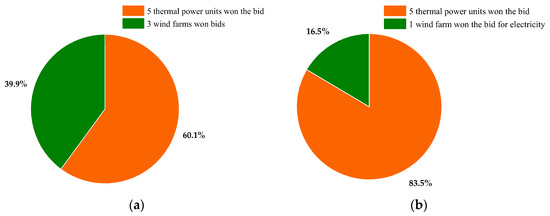
Figure 6.
(a) Case 1 Proportion of wind and thermal power that won the bid; (b) Case 2 Proportion of wind and thermal power that won the bid.
As can be seen from Figure 6, since all the three wind farms in calculation example 1 participated in the bidding, the winning bid of wind power was significantly larger than that of one wind farm in calculation example 2, which made calculation example 1 obtain more daily decomposed electricity in the second stage. In the short-term dispatch model, due to the principle of priority generation of wind turbines, it promotes wind power consumption and reduces the amount of abandoned wind.
- (2)
- Decomposition of monthly contract electricity
Contract electricity is an effective measure to reduce risks and ensure the safe and stable operation of the power grid. According to the decomposition method of contract electricity in Section 2.1, the electricity decomposition results of bidding units for two calculation examples are shown in Table 4.

Table 4.
Decomposition results of contracted electricity for bidding units.
The decomposition of monthly contract electricity is a bridge between medium and long-term transactions and short-term scheduling. Through the decomposition of monthly contract electricity, it can realize the nesting of medium and long-term bidding transactions and short-term unit operation, promote the real-time consumption of wind power, and improve the feasibility of medium and long-term transaction plans. In terms of executability, in Table 4, units 1–5 are the daily decomposition power of thermal power bidding units, and units 5–8 are the daily decomposition power of wind farm bidding units in Case 1. In Case 2, only W1 is the bidding unit, which has the daily contract electricity decomposition value. Moreover, since there is only one auction wind farm in Case 2, the daily abandoned wind power after the monthly electricity is decomposed is much larger than that of the three auction wind farms, and the abandoned wind power of one auction wind farm is two-thirds of the abandoned wind power of the three auction wind farms. This can preliminarily show that the participation of wind farms in bidding can improve wind power consumption; whether it is Case 1 or Case 2, thermal power units 1 and 2 have a larger decomposition value because they are large units and have better bidding advantages. Compared with small units such as units 3 to 5, the wind farms participating in the bidding have a competitive advantage due to their low price and large capacity, and the winning bids are relatively large.
5.3.2. Short-Term Multi-Objective Optimization Scheduling Results
This subsection is the solution result of the optimization model described in Section 2. Comparison of the operating costs, abandoned wind volume and unit output of Case 1 and Case 2 verifies the advantages of wind power participating in bidding transactions: promoting wind power consumption and reducing wind curtailment.
- (1)
- System operating costs
Using CPLEX to solve the short-term multi-objective optimal scheduling model, we finally obtain the system operating cost. Table 5 shows the cost of the two cases; Figure 7 shows the cost distribution of Case 1 and Case 2.

Table 5.
Operating costs of the two cases.
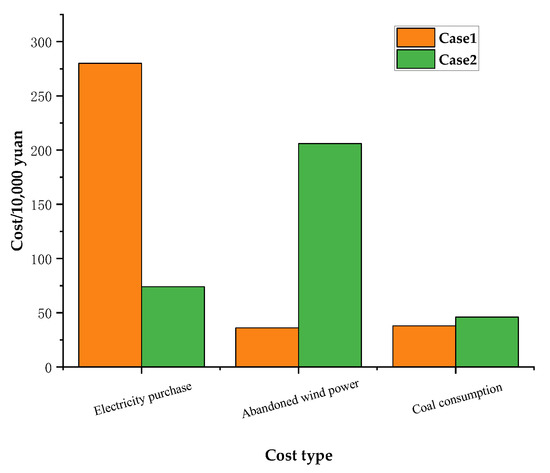
Figure 7.
Cost distribution of two cases.
According to Table 4, the total cost of Case 1 is higher than that of Case 2, but the cost of abandoned wind power is much lower than that of Case 2, which is in line with our optimization goal: to increase wind power consumption and reduce abandoned wind power. From Figure 7, the main cost of Case 1 comes from the power purchase cost (economic cost) of the thermal power units that did not win the bid, and the cost of Case 2 mainly comes from the cost of abandoned wind power (environmental cost) and the low power purchase cost. This is because, compared with Case 2 where one wind farm participates in the market bidding, in Case 1 all wind turbines participate in market-oriented transactions, the more contracted daily electricity is decomposed in the first stage, and the first stage is to abandon wind power. In the least-target decomposition method, in this way, the wind power transaction volume is larger, the contracted power is reasonably distributed, the proportion of clean energy in the system is relatively large, the cost of abandoned wind power is small, and the environmental cost of Case 1 is lower.
- (2)
- Unit output
The optimized output and start-stop conditions of case 1 and case 2 are shown in Figure 8, Figure 9, Figure 10 and Figure 11, respectively. Figure 8 and Figure 9 show the wind power consumption of the wind farms in the two cases during operation; Figure 10 and Figure 11 are the two wind power consumption start and stop output illustrations of the thermal power units in this case.
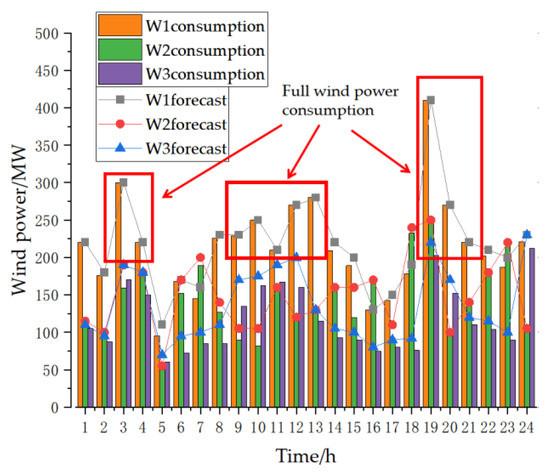
Figure 8.
Wind farm accommodation in Case 1.
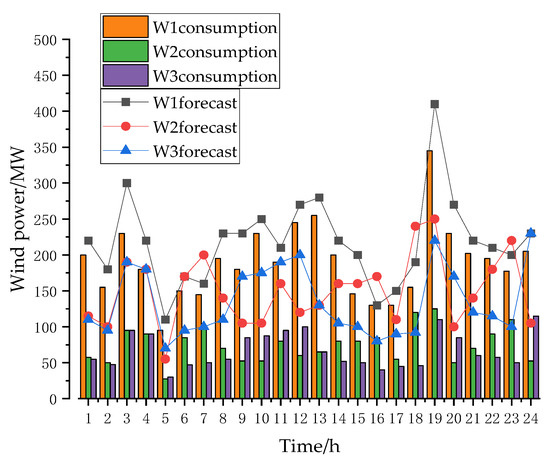
Figure 9.
Wind farm accommodation in Case 2.
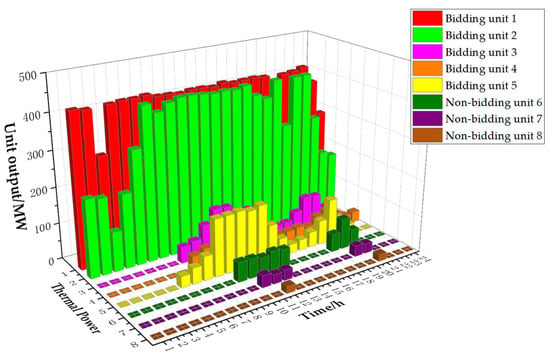
Figure 10.
Output of thermal power unit in Case 1.
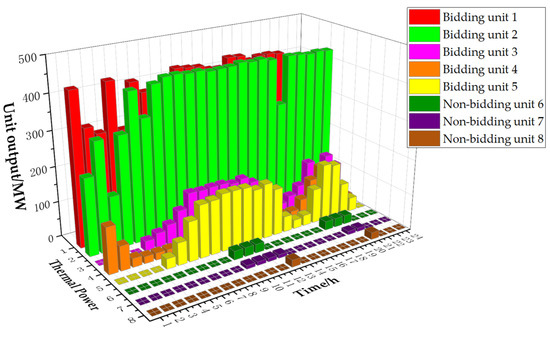
Figure 11.
Output of thermal power unit in Case 2.
The optimized output of wind turbines in Case 1 and Case 2 are shown in Figure 8 and Figure 9, respectively. Comparing the two figures, Case 1 is significantly lower than Case 2’s abandoned air volume. Looking at Figure 8 alone, the bidding wind farm (W1) has no wind curtailment during periods 1, 3–4, 9–13, 16, 19–21, and the second bidding wind farm (W2) also has zero curtailment during peak hours. This is because in Case 1, there are more wind turbines participating in the market, locking in the consumption, and these periods are all peak periods of electricity consumption, and the execution power on the contract day is larger, and the value of the contract power decomposed into each period is larger. At the same time, it can be seen from Figure 9 that in Case 2, one bidding unit (W1) and two non-bidding units (W2, 3) not only did not have zero wind curtailment, but also appeared in periods 2–3 and 16–19. The phenomenon of wind curtailment is due to the fact that the load demand is in the trough during these periods, and the thermal power non-bidding units have been shut down. Due to the large contracted electricity, the output of the thermal power bidding units is already at the lower limit that can be adjusted, and there is no room for adjustment. Therefore, the generation capacity of wind power non-bidding units during the period must be discarded. Since the three wind turbines in Case 1 all participate in medium and long-term transactions, that is, considering the constraints of Equation (39), because the contract power obtained by the optimal decomposition is satisfied, the scheduling will be prioritized to ensure the execution of the contract, and in periods 2, 5. During the load trough stages from 15 to 17, due to the participation of wind power in the bidding, the thermal power bidding units have less electricity and larger dispatching space, thereby promoting the consumption of wind power in the corresponding period and reducing the environmental cost of the entire system operation. From the above analysis, it can be seen that considering the participation of wind power in mid- and long-term market transactions can effectively improve the consumption rate of wind power.
Figure 10 and Figure 11 show the optimized output and start-stop of each unit in Case 1 and Case 2, respectively. As can be seen from Figure 10, in Case 1, bidding units 1 and 2 have output in each time period. This is because these two units have a bidding advantage in the first stage, and their contracted electricity is larger and their output is larger. Units 3, 4, and 5 are all in shutdown during periods 1–5, 23–24, almost the minimum operating state during periods 15–17, and close to the minimum output during periods 6–8, because these periods are all load trough periods, in order to free up scheduling space for clean energy (wind power) consumption, and the bidding advantage in the first stage is not large, and the winning bid is not large, the thermal power bidding unit must choose to shut down or have the smallest output. At the same time, it can be seen that the non-bidding units 6, 7 and 8 only have a certain output during the periods of 10–13 and 19–21. This is due to the peak load state. Among them, the output of these three units decreases in turn. This is because the coal consumption coefficient of these thermal power units increases once. In order to control environmental costs, the output of highly polluting units is also relatively reduced. From Figure 11, since only one wind turbine participates in the monthly market in Case 2, part of the power generation that should have been obtained by wind power is obtained by competition with thermal power generators, and thermal power bidding units have a greater competitive advantage. The output of the unit is much larger than that of Case 1, so that the output of bidding units 1 and 2 is more than that of Case 1, and the output of units 3, 4, and 5 is not all zero in the period 1–5. With many winning bids, the output of these units is less than that of the non-bidding units in Case 1. The minimum thermal power output is only available during the peak load period, and the rest of the time it is in a shutdown state. The output is greater than that of Case 1, which leads to a higher cost of coal consumption and wind curtailment, which is not in line with the purpose of energy conservation and emission reduction in the electricity market reform. Finally, no matter if it is Case 1 or 2, the two types of thermal power generating units have more output during the peak load period and less output during the trough. However, the wind power full-bidding transaction model of Case 1 can better respond to the “double-dual” energy saving and emission reduction according to “carbon” policy.
- (3)
- Abandoned wind power
According to the forecast and actual output of the three wind farms, the respective wind abandonment volumes of the three wind farms in Case 1 and Case 2 can be obtained. The wind abandonment situation is shown in Figure 12.
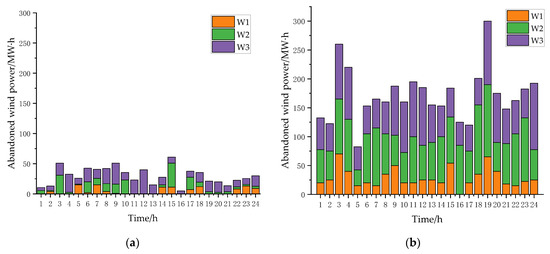
Figure 12.
(a) Case 1 Wind farm curtailment of wind power; (b) Case 2 Wind farm curtailment of wind power.
Figure 12 is a comparison of the abandoned wind power and electricity in the two cases of wind turbines. From the single picture, it can be seen that the two cases have a common trend of abandoned wind power: more wind power was abandoned during the low valley period of electricity consumption, and more abandoned during the peak period. The wind power is relatively small, which is in line with the trend of electricity load; under the same coordinate axis, the abandoned wind power in Case 2 is significantly higher than that in Case 1, and W1 in Case 1 does not even have abandoned wind power during certain periods. In Case 1, during periods 3–4, 6–10, 15, 17–18, the curtailed wind power is larger. This is due to the anti-peak shaving characteristics of wind power. The peak output of wind power occurs in the trough period of the load. If the system compresses more thermal power output to absorb this part of the wind power, the safety of the system operation will not be guaranteed, and compared with the case of full consumption of wind power in the literature [29], reasonable curtailment of wind power can also reduce the economic cost of the system proportion. Because, considering the anti-peak shaving characteristics of wind power, the stability of the system, unit maintenance and load demand balance, properly abandoning the wind power output during this period can improve the safety and economy of system operation. In Case 2, due to the partial bidding, the thermal power combination accounts for a large proportion of the output. Whether it is in the load trough or the peak period, this abandoned wind power remains high, and it is larger than the abandoned wind in Case 1.
This section analyzes the short-term multi-objective optimization results. The amount of abandoned wind power and coal consumption cost in Case 1 is much smaller than that in Case 2, and the operation of its units is also better than that in Case 2. Thermal power units not only do not start and stop frequently, but also cause high pollution. The output of thermal power units is also significantly less, which indicates that wind power participation in bidding transactions can improve wind power consumption. The nested optimization model of long-term transaction power and short-term dispatch proposed in this paper can not only reduce wind curtailment, but also improve the operating economy of the system.
6. Conclusions
Based on the characteristics of wind power and the problem of wind power consumption at the current stage, this paper proposes a connection model of mid- and long-term combined wind and thermal power decomposition and short-term scheduling after the monthly wind-thermal joint bidding transaction ends. The conclusion is as follows:
- (1)
- After wind power and thermal power jointly participate in mid-to-long-term bidding transactions, the monthly contract electricity is decomposed on a daily basis. Different from the traditional distribution method according to the proportion of capacity, the decomposition method in this paper considers the power generation characteristics of wind power and thermal power, and divides the monthly electricity. It is effectively decomposed into days, realizing the nesting of medium and long-term bidding transactions and short-term unit operation.
- (2)
- In order to improve the real-time consumption of wind power, this paper establishes a short-term multi-objective optimal dispatch model, aiming at the minimum economic cost and environmental cost, and coordinating the output of bidding units and non-bidding units. On the premise of ensuring the safe operation of the system, it can maximize the real-time consumption of wind power.
- (3)
- This paper builds a wind power consumption model that connects mid- and long-term transaction power decomposition and short-term dispatch, which can promote wind power consumption from both the market and dispatch levels, increase the economic benefits of wind power grid connection, and reduce the environmental cost of the system. Together with wind power, it can also ensure the economical operation of the system.
- (4)
- According to the optimization results of Case 1 and Case 2, more wind power participating in mid- and long-term bidding transactions can improve wind power consumption and reduce the coal consumption cost of the wind-fired integrated system. Therefore, with the gradual increase in wind power installed capacity and the development of market reform, participation in mid- and long-term bidding transactions will be the future development trend of wind power generation.
Author Contributions
Conceptualization, Y.Z. and K.Z.; methodology, K.Z.; software, Y.Z.; validation, Y.Z., K.Z. and G.Z.; formal analysis, G.Z.; resources, G.Z.; writing—original draft preparation, G.Z. and K.Z.; writing—review and editing, Y.Z., K.Z. and G.Z.; visualization, T.X. and X.H.; supervision, T.X.; project administration, G.Z.; funding acquisition, G.Z. All authors have read and agreed to the published version of the manuscript.
Funding
Shaanxi Province Natural Science Basic Research Program (2022JQ-534); This research was funded by Key Research and Development Plan of Shaanxi Province (2018-ZDCXL-GY-10-04), Natural Science Basic Research Program of Shaanxi (Program No. 2019JLZ-15).
Institutional Review Board Statement
Not applicable.
Informed Consent Statement
Not applicable.
Data Availability Statement
Not applicable.
Conflicts of Interest
The authors declare no conflict of interest.
Abbreviations
| Monthly electricity breakdown total operating cost | |
| The weight coefficients of the three sub-goal costs | |
| Abandoned wind power cost | |
| Bidding Wind Farm Daily Decomposition Electricity | |
| The maximum power generation capacity of the bidding wind farm | |
| Electricity decomposition days | |
| Bidding wind farms | |
| Bidding wind farm maintenance status | |
| Bidding thermal power unit status | |
| Unit maintenance cost | |
| Bidding number of thermal power units | |
| The maximum power generation capacity of the bidding thermal power unit | |
| Unit maintenance factor | |
| Bidding progress of thermal power units | |
| The maximum on-grid electricity of thermal power plants | |
| Bidding thermal power unit daily decomposition electricity | |
| Thermal power plant monthly contract electricity | |
| Thermal power plant progress factor | |
| Average value of progress factor of thermal power plant | |
| Wind power auction winning bid | |
| Thermal Power Bidding Winning Electricity | |
| Decomposition electricity per day | |
| Minimum load power per day | |
| The minimum power generation capacity of bidding thermal power units | |
| The maximum power generation capacity of bidding thermal power units | |
| The minimum power generation capacity of bidding wind farms | |
| The maximum power generation capacity of bidding wind farms | |
| Bidding wind farm maintenance time | |
| Bidding thermal power unit maintenance time | |
| Economic cost of electricity purchase | |
| The power purchase cost of the auctioned wind farm that fails to win the bid and is dispatched to the output | |
| Short-term scheduling period | |
| On-grid tariff for non-bidding units | |
| Bidding wind farm dispatch output | |
| Bidding wind farms to fulfill contracts | |
| Hours per unit period | |
| Non-bidding wind farm output | |
| Number of non-bidding wind farms | |
| Non-bidding wind farm power purchase cost | |
| Fire Bidding on-grid electricity price for thermal power units | |
| Bidding thermal power units to fulfill the contract | |
| Bidding for dispatching output of thermal power plants | |
| The power purchase cost of the thermal power bidding unit that fails to win the bid and is dispatched to output | |
| Power purchase cost of non-bidding thermal power units | |
| Number of non-bidding thermal power units | |
| Non-bidding thermal power unit output | |
| Short-term scheduling environment operating costs | |
| Short-term dispatch wind farm curtailment cost | |
| Coal consumption cost of thermal power unit operation | |
| Wind farm cost factor | |
| Wind farm forecast output | |
| Coal consumption coefficient of thermal power unit | |
| total short run cost | |
| Short-term operation of each cost weight coefficient | |
| The load demand of the system at each time period | |
| Minimum output of thermal power unit | |
| Maximum output of thermal power unit | |
| Wind power reserve factor | |
| Load reserve factor | |
| Thermal power unit running status | |
| The allowable drop rate of output power per minute of thermal power units | |
| The allowable rising speed of the output power per minute of the thermal power unit | |
| Continuous outage time of thermal power units | |
| Continuous running time of thermal power unit | |
| The minimum time that a thermal power unit must remain out of operation | |
| The minimum time a thermal power unit must remain in operation | |
| Abandoned wind power accepted by grid companies | |
| Total abandoned wind power | |
| Bidding wind farm contract day execution power | |
| Tolerance for the deviation of the completed electricity quantity on the contract day of the bidding wind farm | |
| Contract day execution power of bidding thermal power units |
References
- Huang, W.; Wang, Q.; Li, H.; Fan, H.; Qian, Y.; Klemeš, J.J. Review of recent progress of emission trading policy in China. J. Clean. Prod. 2022, 349, 131480. [Google Scholar] [CrossRef]
- Guo, W.; Liu, P.; Shu, X. Optimal dispatching of electric-thermal interconnected virtual power plant considering market trading mechanism. J. Clean. Prod. 2020, 279, 123446. [Google Scholar] [CrossRef]
- Zhang, C.; Wang, S.; Zhao, Q. Distributed economic MPC for LFC of multi-area power system with wind power plants in power market environment. Int. J. Electr. Power Energy Syst. 2021, 126, 106548. [Google Scholar] [CrossRef]
- Algieri, A.; Morrone, P.; Bova, S. Techno-Economic Analysis of Biofuel, Solar and Wind Multi-Source Small-Scale CHP Systems. Energies 2020, 13, 3002. [Google Scholar] [CrossRef]
- Mu, Y.; Li, H.; Yu, X.; Jia, H.; Wang, M.; Hou, K.; Wang, Z. A scenario-based optimal dispatch for joint operation of wind farms and combined heat and power plants considering energy flexibilities in heating networks. Electr. Power Syst. Res. 2022, 204, 107683. [Google Scholar] [CrossRef]
- Zhang, S.; Zhang, K.; Zhang, G.; Xie, T.; Wen, J.; Feng, C.; Ben, W. The Bi-Level Optimization Model Research for Energy-Intensive Load and Energy Storage System Considering Congested Wind Power Consumption. Processes 2021, 10, 51. [Google Scholar] [CrossRef]
- Hauer, I.; Balischewski, S.; Ziegler, C. Design and operation strategy for multi-use application of battery energy storage in wind farms—ScienceDirect. J. Energy Storage 2020, 31, 101572. [Google Scholar] [CrossRef]
- Li, J.; Fu, Y.; Xing, Z.; Zhang, X.; Zhang, Z.; Fan, X. Coordination Scheduling Model of Multi-type Flexible Load for Increasing Wind Power Utilization. IEEE Access 2019, 7, 105840–105850. [Google Scholar] [CrossRef]
- Chen, Z.; Li, Z.; Guo, C.; Ding, Y.; He, Y. Two-Stage Chance-Constrained Unit Commitment Based on Optimal Wind Power Consumption Point Considering Battery Energy Storage. IET Gener. Transm. Distrib. 2020, 14, 3738–3749. [Google Scholar] [CrossRef]
- Simla, T.; Stanek, W. Reducing the impact of wind farms on the electric power system by the use of energy storage. Renew. Energy 2020, 145, 772–782. [Google Scholar] [CrossRef]
- Rong, S.; Chen, X.; Guan, W.; Xu, M. Coordinated dispatching strategy of multiple energy sources for wind power consumption. J. Mod. Power Syst. Clean Energy 2019, 11, 1461–1471. [Google Scholar] [CrossRef]
- Yang, Y.; Zhou, J.; Liu, G.; Mo, L.; Wang, Y.; Jia, B.; He, F. Multi-plan formulation of hydropower generation considering uncertainty of wind power. Appl. Energy 2020, 260, 114239. [Google Scholar] [CrossRef]
- Jiang, T.; Min, Y.; Zhou, G.; Chen, L.; Chen, Q.; Xu, F. Dispatch Model for Integrated Heat and Power Systems Considering Internal Composition of CHP Plants. J. Chin. Soc. Electr. Eng. 2021, 7, 12. [Google Scholar]
- Xu, J.; Chen, Y.; Liao, S.; Sun, Y.; Yao, L.; Fu, H.; Jiang, X.; Ke, D.; Li, X.; Yang, J.; et al. Demand side industrial load control for local utilization of wind power in isolated grids. Appl. Energy 2019, 243, 47–56. [Google Scholar] [CrossRef]
- Tan, Q.; Mei, S.; Ye, Q.; Ding, Y.; Zhang, Y. Optimization Model of a Combined Wind–PV–Thermal Dispatching System under Carbon Emissions Trading in China. J. Clean. Prod. 2019, 225, 391–404. [Google Scholar] [CrossRef]
- Zhang, X.; Zheng, L. Coordinated dispatch of the wind-thermal power system by optimizing electric vehicle charging. Clust. Comput. 2018, 22, 8835–8845. [Google Scholar] [CrossRef]
- Tan, Q.; Ding, Y.; Zheng, J.; Dai, M.; Zhang, Y. The Effects of Carbon Emissions Trading and Renewable Portfolio Standards on the Integrated Wind–Photovoltaic–Thermal Power-Dispatching System: Real Case Studies in China. Energy 2021, 222, 119927. [Google Scholar] [CrossRef]
- Lu, M.; Guan, J.; Wu, H.; Chen, H.; Gu, W.; Wu, Y.; Ling, C.; Zhang, L. Day-ahead optimal dispatching of multi-source power system. Renew. Energy 2022, 183, 435–446. [Google Scholar] [CrossRef]
- Dong, J.; Li, P.; Zhang, K.; Ren, W.; He, P.; Cao, M. Multi-objective-constraint optimal model for wind-hydro-thermal power joint scheduling based on symbiotic organisms search algorithm. Int. Trans. Electr. Energy Syst. 2021, 31, e12841. [Google Scholar] [CrossRef]
- Jiang, S.; Zhang, C.; Wu, W.; Chen, S. Combined Economic and Emission Dispatch Problem of Wind-Thermal Power System Using Gravitational Particle Swarm Optimization Algorithm. Math. Probl. Eng. 2019, 2019, 5679361. [Google Scholar] [CrossRef]
- Dasgupta, K.; Roy, P.K.; Mukherjee, V. A novel oppositional learning-based chaotic sine cosine algorithm for the dynamic thermal–wind economic dispatch problem. Eng. Optim. 2021, 1–19. [Google Scholar] [CrossRef]
- Yang, X.Y.; Liu, X.Y.; Guo, Q.; Sun, Y.; Yan, G.; Li, H.Y. Coordinated planning method for energy storage and thermal power unit flexibility transformation considering the benefits of auxiliary services. Power Grid Technol. 2022, 1–14. [Google Scholar] [CrossRef]
- Xu, X.; Niu, D.; Xiao, B.; Guo, X.; Zhang, L.; Wang, K. Policy analysis for grid parity of wind power generation in China. Energy Policy 2020, 138, 111225. [Google Scholar] [CrossRef]
- Zhang, R.; Ni, M.; Shen, G.Q.; Wong, J.K. An analysis on the effectiveness and determinants of the wind power Feed-in-Tariff policy at China’s national-level and regional-grid-level. Sustain. Energy Technol. Assess. 2019, 34, 87–96. [Google Scholar] [CrossRef]
- Dong, J.; Fu, A.; Liu, Y.; Nie, S.; Yang, P.; Nie, L. Two-Stage Optimization Model for Two-Side Daily Reserve Capacity of a Power System Considering Demand Response and Wind Power Consumption. Sustainability 2019, 11, 7171. [Google Scholar] [CrossRef]
- Zhang, J.; Cheng, C.; Yu, S.; Su, H. Chance-constrained co-optimization for day-ahead generation and reserve scheduling of cascade hydropower–variable renewable energy hybrid systems. Appl. Energy 2022, 324, 119732. [Google Scholar] [CrossRef]
- Jiang, Y.; Yu, S.; Wen, B. Monthly electricity purchase and decomposition optimization considering wind power accommodation and day-ahead schedule. Int. J. Electr. Power Energy Syst. 2019, 107, 231–238. [Google Scholar] [CrossRef]
- Fan, W.; Huang, L.; Cong, B.; Tan, Z.; Xing, T. Research on an optimization model for wind power and thermal power participating in two-level power market transactions. Int. J. Electr. Power Energy Syst. 2022, 134, 107423. [Google Scholar] [CrossRef]
- Cao, H.; Qiu, Z.; Xiang, J.; Hao, Y.; Gui, W. A wind power consumption model considering the connection between mid- and long-term transactions and short-term dispatch. Power Grid Technol. 2020, 44, 4200–4210. [Google Scholar] [CrossRef]
- Dong, Y.; Jiang, X.; Ren, M.; Yuan, J. Environmental implications of China’s wind-coal combined power generation system. Resour. Conserv. Recycl. 2019, 142, 24–33. [Google Scholar] [CrossRef]
- Zhao, S.Q.; Hu, L.N.; Tian, J.F.; Xu, Z.Y. Contract power decomposition model of multi-energy power system based on mid-long term wind power and photovoltaic electricity forecasting. Electr. Power Autom. Equip. 2019, 39, 13–19. [Google Scholar]
- Yao, J.; Yang, S.; Wang, K.; Zeng, D.; Mao, W.; Geng, J. Framework and strategy design of demand response scheduling for balancing wind power fluctuation. Autom. Electr. Power Syst. 2014, 38, 85–92. [Google Scholar]
Publisher’s Note: MDPI stays neutral with regard to jurisdictional claims in published maps and institutional affiliations. |
© 2022 by the authors. Licensee MDPI, Basel, Switzerland. This article is an open access article distributed under the terms and conditions of the Creative Commons Attribution (CC BY) license (https://creativecommons.org/licenses/by/4.0/).